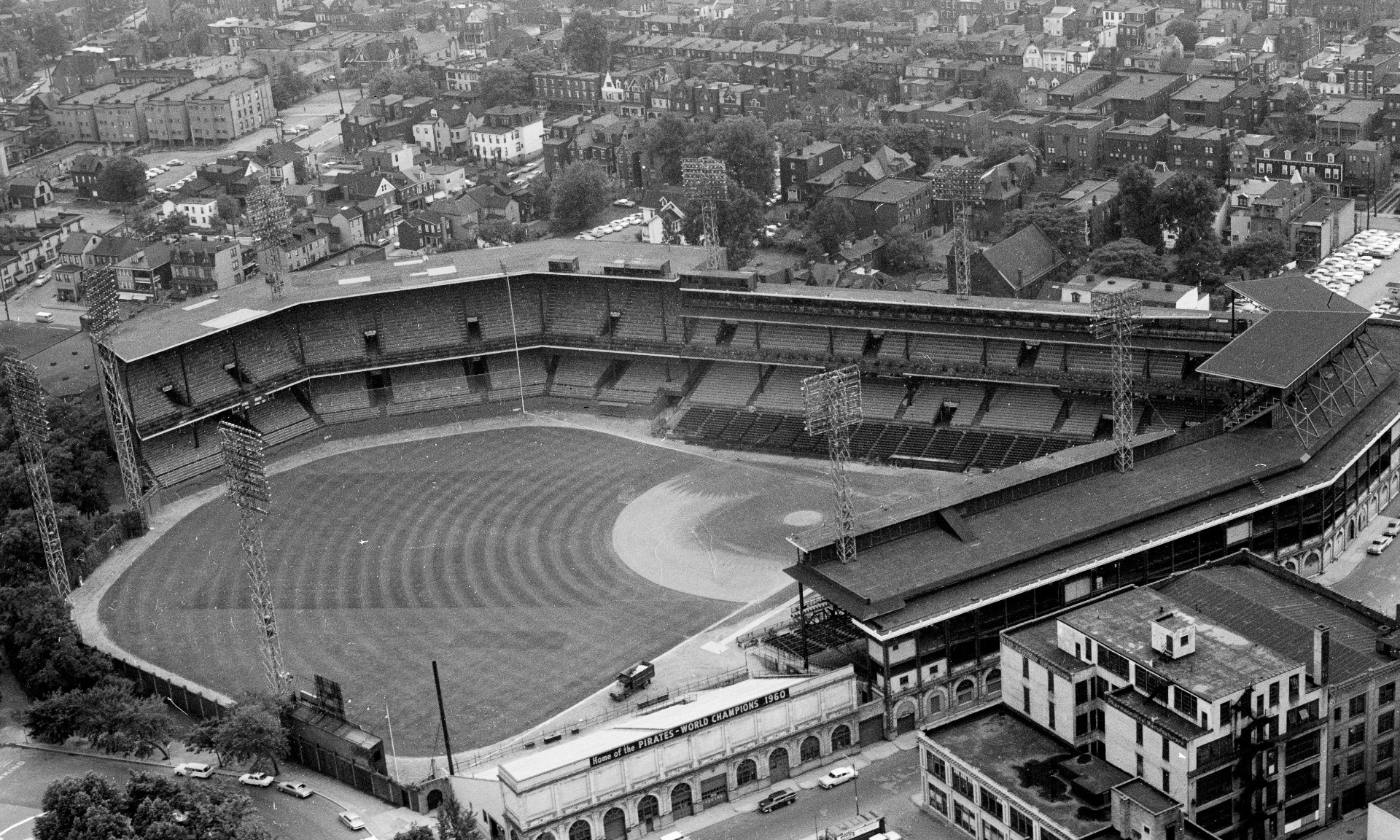For the fourth edition of the stadium series, we’re going back to another old-school ballpark. Keeping with the Pennsylvania theme, this week’s edition is Forbes Field, home of the Pittsburgh Pirates from 1909 to 1970.
The History of Forbes Field
Forbes Field was always a happening spot. Across its 61 years of existence, the stadium hosted six professional sports teams. The Pirates owned Forbes Field, but the stadium also housed the Pittsburgh Steelers (1933-1963), University of Pittsburgh football (1909-1924), the Homestead Grays (1922-1939), the Pittsburgh Americans (1936-1937), and the Pittsburgh Phantoms (1967).
In 1943, Forbes was also home to the Philadelphia-Pittsburgh Steagles. Okay, let me explain.
During that time, many NFL teams were losing players who were being drafted to fight in World War II. The Eagles and Steelers were hit particularly hard by the draft, and found themselves so shorthanded that the NFL decided to combine the two teams for the 1943 season. The “Steagles” played four home games at Shibe Park in Philadelphia, and two others at Forbes Field.
With a Little Help From My (Super Rich) Friends
Before Forbes Field, the Pirates’ home was Exposition Park. By 1903, Pirates owner Barney Dreyfuss was looking to build a new stadium with a larger capacity. With the financial help of his friend Andrew Carnegie, Dreyfuss purchased land in Pittsburgh and began constructing a new stadium.
Initially, the land around the stadium was mostly undeveloped. It was also located outside of downtown Pittsburgh. This seemed like a bad combination, but Dreyfuss had intentionally purchased cheaper land so that he could allot more funding to the stadium itself.
Forbes Field was built out of steel and concrete, which was unusual for parks of its era. Construction was completed just 122 days after ground was broken.
Right off the bat, the stadium was a major success, featuring many new innovations for ballparks at the time. It was named Forbes Field, as it rested on Forbes Avenue, itself named for British general John Forbes.
A Pitcher’s Best Friend, Sometimes
With Dreyfuss reportedly despising “cheap” home runs, he ensured that the dimensions of the park were absolutely massive.

In 1925, the right-field line (which was originally 376 feet from home) was moved in after bleachers were added to the area. While this increased the capacity of Forbes Field, it also brought the right-field line in to just 300 feet. Dreyfuss was naturally not a huge fan of this, and decided to place a 28-foot-tall screen in right by 1930.
Forbes Field: Third Time’s the Charm
With the large dimensions, Forbes Field was a hotbed for triples and inside-the-park home runs. In one game in May 1925, the Pirates set an MLB record with eight triples.
Triple plays (specifically unassisted ones) also were surprisingly common at the park. Glenn Wright turned two unassisted triple plays at Forbes Field in his career. The first came with the Pirates in 1925, while he turned the second as a member of the Chicago Cubs in 1927. As Curt Smith says, there were more unassisted triple plays than there were no-hitters in Forbes Field’s history.
Continuing the theme of three, Forbes was also once host to a tripleheader, an idea that Ernie Banks probably wished he’d have thought of. In 1920, the Pirates hosted the Cincinnati Reds for a set of three games in just a single day. The Reds took two of three on the day, winning the first two games before the Pirates salvaged the third and final contest.
Ahead of the Pack
Forbes Field was a bit of a trendsetter, in more ways than one. Its steel and concrete structure was already uncommon, but it was also the first stadium to use a tarp for the field, the first to pad the outfield walls, and the first to host a live radio broadcast.
In 1921, live baseball was broadcast to the radio from Forbes Field. Harold Arlin, a 26-year-old employee of KDKA, used a telephone to call games from inside the stadium. The first broadcast, with Arlin on the call, ended with the Pirates defeating the Phillies 8-5.
Forbes was also the first stadium to employ ramps that lead to seats for fans, and the first to use elevators.
Success at Forbes
Throughout its history, Forbes Field wasn’t just another ballpark. It was a place to be. Forbes found itself host to many all-time players, and some very good Pirates teams.
The first-ever game played at the stadium saw Honus Wagner at shortstop for the Pirates. Legends like Roberto Clemente, Ralph Kiner, Willie Stargell, Arky Vaughan, and Paul Waner all spent time playing in front of the home crowd at Forbes.
In the 61 seasons at Forbes Field, the Pirates won four National League pennants, winning the World Series three of those times. In 1909, the inaugural season at the ballpark, the Pirates won their first-ever World Series, defeating the Detroit Tigers in seven games.
1925 saw the Pirates clinch the World Series in front of the home crowd at Forbes for the first time, beating the Washington Senators at home in Game 7. An eight-inning rally, started by back to back two-out doubles, led to the Pirates taking a 9-7 lead, giving them their second championship.
Maz’s Moment
The 1960 World Series was the backdrop to not only the most famous moment in the history of Forbes Field, but one of the all-time moments in baseball history.
The Yankees had blown out the Pirates in Game 6, 12-0, to force Game 7. The Pirates returned home, hoping to fend off the Bombers, who had exploded offensively in their three wins. The Yanks had won Game 2 (16-3), and Game 3 (10-0), before their Game 6 victory.
The game was an exciting, offense-driven affair. The Pirates initially went up 4-0, before the Yankees scored seven unanswered to take a 7-4 lead. In the eighth, the Pirates plated five, giving them a 9-7 lead. But the Yankees responded, scoring two runs to tie the game in the top of the 9th.
You know how the story goes from here. Bill Mazeroski led off the inning, and hit a ball over the left-field wall at Forbes Field. The walk-off homer gave the Pirates their third World Series championship.
Mazeroski’s career-defining blast was the only Series-clinching walk-off home run until Joe Carter’s in 1993. Perhaps less notably, it is still the only game in MLB postseason history to not feature a single strikeout.
Life After Forbes
In 1970, the Pirates left Forbes Field, moving to Three Rivers Stadium. The new stadium had been built to accommodate both the Pirates and the Pittsburgh Steelers, who once shared the facilities at Forbes.
The Pirates played at Three Rivers Stadium until the year 2000, when they moved into their own stadium, PNC Park.
Forbes Field: Specs
Opened: 1909
Closed: 1970
Capacity:
- 25,000 (1909-1924)
- 41,000 (1925-1969)
- 35,000 (1970)
Final Dimensions:
- Left Field: 365 feet
- Center Field: 457 feet
- Right Field: 300 feet
Information from:




